Pilosocereus
| Pilosocereus | |
|---|---|
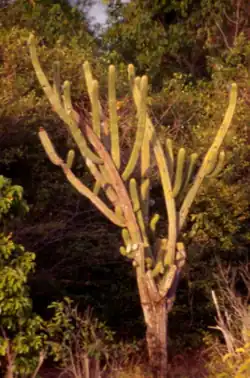
| |
| Pilosocereus catingicola | |
| Scientific classification | |
| Kingdom: | Plantae |
| Clade: | Tracheophytes |
| Clade: | Angiosperms |
| Clade: | Eudicots |
| Order: | Caryophyllales |
| Family: | Cactaceae |
| Subfamily: | Cactoideae |
| Tribe: | Cereeae |
| Subtribe: | Cereinae |
| Genus: | Byles & G.D.Rowley[1] |
| Type species | |
| Pilosocereus leucocephalus (Poselg.) Byles & G.D.Rowley[2]
| |
| Species | |
|
See text | |
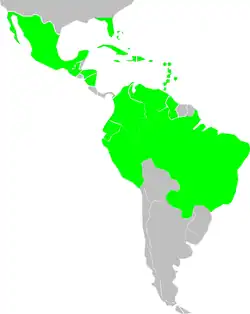
| |
| Approximate distribution[1] | |
| Synonyms | |
Pilosocereus (from Latin, "hairy cereus") is a genus of cactus native to the Neotropics. Tree cactus is a common name for Pilosocereus species.[3] The genus Pseudopilocereus is a synonym of this genus.[1] For many years, the illegitimate name Pilocereus was used for this genus, although properly a synonym for Cephalocereus.[4] The subdivision of the genus has varied very widely, resulting in very different numbers of species being accepted.
The commonly cultivated Pilosocereus pachycladus (syn. Pilosocereus azureus) is a blue cactus with hairy areoles that emit golden spines.
Description
Species of the genus Pilosocereus are columnar cacti with a shrubby or tree-like habit. Some may be up to 7 m (23 ft) tall. They may be unbranched, or have a dense mass of branches. The stems vary widely in the number of ribs and spines. The areoles may have long or short hairs, sometimes with more silky hairs on flowering areoles than on non-flowering ones. A few species have a pseudocephalium. The flowers usually open at night and may smell strongly of garlic. The fruits have white, red-purple or other-colored pulp when ripe.[5][6]
Taxonomy
The taxonomic history of the genus name Pilosocereus is somewhat complicated. In 1838, Charles Antoine Lemaire created a section within the genus Cereus, C. sect. Cephalophori, based on Cereus senilis and C. columna-trajani. In the same year, Ludwig Pfeiffer published the genus name Cephalocereus, also based on Cereus senilis. In 1839, Lemaire raised his Cereus sect. Cephalophori to a genus under the name Pilocereus, presumably unaware of Pfeiffer's earlier name. Since both Cephalocereus and Pilocereus are based on the same type (i.e. Cereus senilis), the later of the two names is superfluous, and so must be rejected under the International Code of Nomenclature for algae, fungi, and plants (ICNafp).[4] In 1894, Karl Moritz Schumann decided that Lemaire's Cereus sect. Cephalophori needed to be split into two genera, rather than treated as one genus. He retained Pfeiffer's Cephalocereus, and attempted to use Pilocereus for the other.[7] Schumann removed from Pilocereus both of the species originally designated by Lemaire; however, this is not allowed by the ICNafp which requires that a name is permanently attached to its type, so Pilocereus sensu Schumann is equally illegitimate.[4]
Subsequently, the genus name Pilocereus was widely used and several attempts were made to legitimize it. One possible solution would have been to conserve Schumann's name against Lemaire's. However, a proposal to do so was not accepted by the 1954 International Botanical Congress.[4] In 1957, Ronald Stewart Byles and Gordon Rowley provided a solution by publishing Pilosocereus with the type species Pilocereus leucocephalus (which thus became Pilosocereus leucocephalus). They also provided names in Pilosocereus for all the species then placed in Pilocereus.[8]
The number of species recognized within the genus has varied very considerably. Taking the Caribbean and northern Andes as an example, Britton and Rose accepted 18 species in their 1920 treatment (which used the genus Cephalocereus). Many later authors followed this approach when Cephalocereus was split and the relevant species placed in what is now Pilosocereus. Alternatively, treatments in the late 1990s and early 2000s used much more broadly circumscribed species, resulting in many fewer being recognized, for example as few as two or three replaced the 18 of Britton and Rose. A 2019 review of Pilosocereus in the Caribbean and northern Andes returned to a larger number of species with narrower circumscriptions.[6] A 2020 molecular phylogenetic study of the genus resulted in three species being moved to a new genus Xiquexique to maintain the monophyly of Pilosocereus, which the authors considered to have 42 species placed in two subgenera, Pilosocereus subg. Pilosocereus and Pilosocereus subg. Gounellea.[5] As of July 2025, Plants of the World Online accepted 56 species, including a natural hybrid.[1]
Species
As of July 2025, Plants of the World Online accepted the following species:[1]
| Image | Scientific name | Distribution |
|---|---|---|
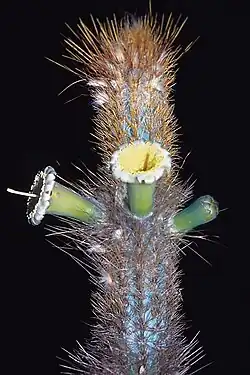 |
Pilosocereus albisummus P.J.Braun & Esteves | Minas Gerais, Brazil |
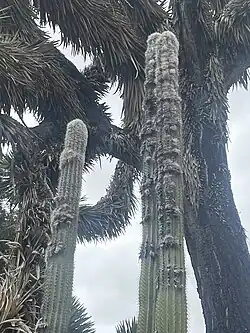 |
Pilosocereus alensis (F.A.C.Weber ex Rol.-Goss.) Byles & G.D.Rowley | Western Mexico |
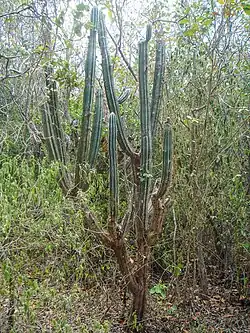 |
Pilosocereus armatus (Otto ex Pfeiff.) A.R.Franck | Puerto Rico and the Virgin Islands |
 |
Pilosocereus arrabidae (Steud.) Byles & G.D.Rowley | Brazil |
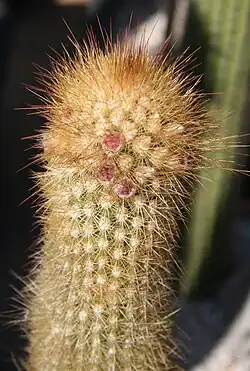 |
Pilosocereus aureispinus (Buining & Brederoo) F.Ritter | Brazil |
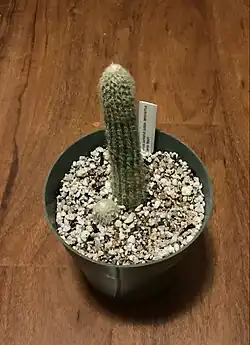 |
Pilosocereus aurisetus (Werderm.) Byles & G.D.Rowley | Minas Gerais, Brazil |
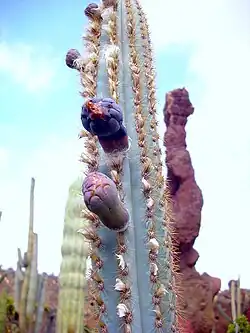 |
Pilosocereus azulensis N.P.Taylor & Zappi | Minas Gerais, Brazil |
| Pilosocereus brasiliensis (Britton & Rose) Backeb. | East Brazil | |
| Pilosocereus brauniorum (Esteves) N.P.Taylor & Zappi | Minas Gerais, Brazil | |
| Pilosocereus brevispinus Hoxey & Gdaniec | Central Hispaniola | |
| Pilosocereus brooksianus (Britton & Rose) Byles & G.D.Rowley | Southeast Cuba | |
| Pilosocereus catalani (Riccob.) Byles & G.D.Rowley | Unknown, possibly Brazil | |
| Pilosocereus catimbauensis (N.P.Taylor & Albuq.-Lima) N.P.Taylor & Albuq.-Lima | Pernambuco, Brazil | |
 |
Pilosocereus catingicola (Gürke) Byles & G.D.Rowley | Rio Grande do Norte, Pernambuco, Alagoas, Sergipe, Paraíba, Bahia. |
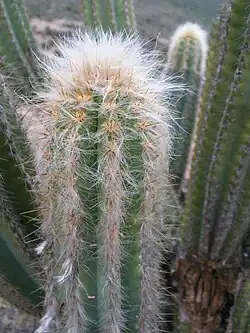 |
Pilosocereus chrysacanthus (F.A.C.Weber ex K.Schum.) Byles & G.D.Rowley | Mexico and Honduras |
_Byles_%2526_G.D.Rowley.jpg) |
Pilosocereus chrysostele (Vaupel) Byles & G.D.Rowley | Brazil |
| Pilosocereus collinsii (Britton & Rose) Byles & G.D.Rowley | Oaxaca, Mexico | |
| Pilosocereus colombianus (Rose) Byles & G.D.Rowley | Colombia, Ecuador | |
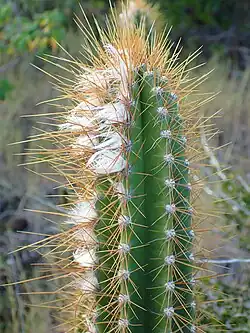 |
Pilosocereus curtisii (Otto) A.R.Franck | The Lesser Antilles and the British Virgin Islands |
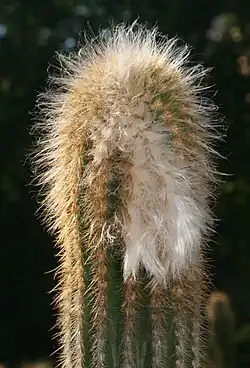 |
Pilosocereus densiareolatus F.Ritter | East Brazil |
_P.J._Braun_flowering.jpg) |
Pilosocereus diersianus (Esteves) P.J.Braun | Tocantins and Goiás |
| Pilosocereus excelsus Hoxey & Gdaniec | East Dominican Republic | |
| Pilosocereus flavipulvinatus (Buining & Brederoo) F.Ritter | Northern Brazil | |
| Pilosocereus flexibilispinus P.J.Braun & Esteves | Central Brazil | |
| Pilosocereus floccosus Byles & G.D.Rowley | East Brazil | |
 |
Pilosocereus fulvilanatus (Buining & Brederoo) F.Ritter | Minas Gerais, Brazil |
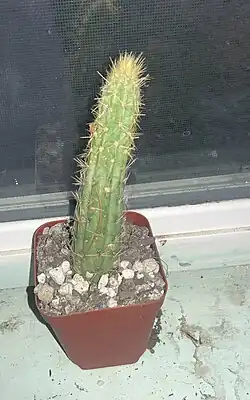 |
Pilosocereus gaumeri (Britton & Rose) Backeb. | Southeast Mexico |
_Byles_%2526_G.D.Rowley.jpg) |
Pilosocereus glaucochrous (Werderm.) Byles & G.D.Rowley | Northeast Brazil |
| Pilosocereus jamaicensis Proctor | Cayman Islands, Jamaica | |
| Pilosocereus juaruensis (Buining & Brederoo) P.J.Braun | Central Brazil, Northeast Paraguay | |
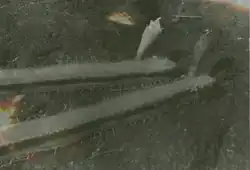 |
Pilosocereus kanukuensis (Alexander) Leuenb. | Kanuku mountains, Venezuela |
| Pilosocereus lanuginosus (L.) Byles & G.D.Rowley | Netherlands Antilles | |
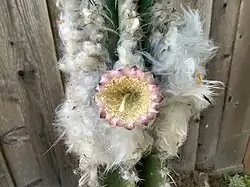 |
Pilosocereus leucocephalus (Poselg.) Byles & G.D.Rowley | Mexico, Honduras |
| Pilosocereus machrisii (E.Y.Dawson) Backeb. | Brazil | |
| Pilosocereus magnificus (Buining & Brederoo) F.Ritter ex D.R.Hunt | Southeast Brazil | |
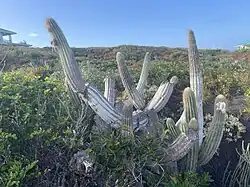 |
Pilosocereus millspaughii (Britton) Byles & G.D.Rowley | Florida (Locally extinct), The Antilles |
| Pilosocereus mollispinus P.J.Braun & Esteves | Goias, Brazil | |
| Pilosocereus moritzianus (Otto ex Pfeiff.) Byles & G.D.Rowley | Lesser Antilles, Northern Venezuela | |
| Pilosocereus multicostatus F.Ritter | Southeast Brazil | |
| Pilosocereus occultiflorus P.J.Braun & Esteves | Minas Gerais, Brazil | |
| Pilosocereus oligolepis (Vaupel) Byles & G.D.Rowley | Guyana, Brazil, possibly Venezuela | |
 |
Pilosocereus pachycladus F.Ritter | Minas Gerais, Brazil |
| Pilosocereus parvus (Diers & Esteves) P.J.Braun | Central Brazil | |
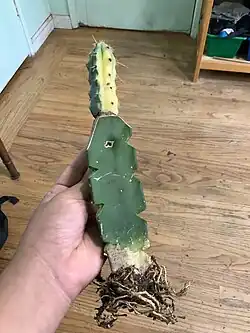 |
Pilosocereus pentaedrophorus (Labour.) Byles & G.D.Rowley | East Brazil |
| Pilosocereus piauhyensis (Gürke) Byles & G.D.Rowley | Piaui, Brazil | |
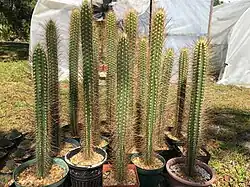 |
Pilosocereus polygonus (Lam.) Byles & G.D.Rowley | Central Hispaniola |
| Pilosocereus × pseudosuperfloccosus P.J.Braun & Esteves | Bahia, Brazil | |
| Pilosocereus purpusii (Britton & Rose) Byles & G.D.Rowley | Zacatecas, Mexico | |
| Pilosocereus pusillibaccatus P.J.Braun & Esteves | North Brazil | |
.jpg) |
Pilosocereus quadricentralis (E.Y.Dawson) Backeb. | Oaxaca and Chiapas |
| Pilosocereus robinii (Lem.) Byles & G.D.Rowley | Florida and the Bahamas | |
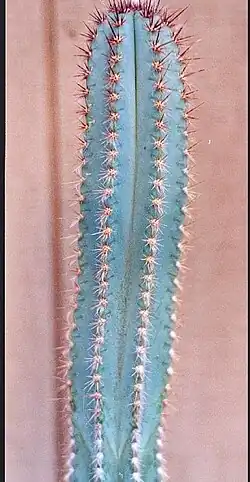 |
Pilosocereus rosae P.J.Braun | Minas Gerais, Brazil |
| Pilosocereus samanensis Hoxey & Gdaniec | Northeast Dominican Republic | |
| Pilosocereus splendidus F.Ritter | Bahia, Brazil | |
| Pilosocereus × subsimilis Rizzini & A.Mattos | Minas Gerais, Brazil | |
| Pilosocereus tillianus R.Gruber & Schatzl | Mérida, Venezuela | |
| Pilosocereus vilaboensis (Diers & Esteves) P.J.Braun | West-central Brazil | |
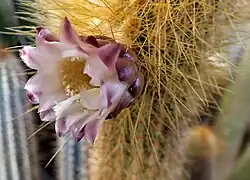 |
Pilosocereus zahrae P.J.Braun | Bahia, Brazil |
References
- ^ a b c d e f "Pilosocereus Byles & G.D.Rowley". Plants of the World Online. Royal Botanic Gardens, Kew. Retrieved 2025-07-30.
- ^ a b "Pilosocereus Byles & G.D.Rowley". International Plant Names Index (IPNI). Royal Botanic Gardens, Kew; Harvard University Herbaria & Libraries; Australian National Botanic Gardens. Retrieved 2025-06-26.
- ^ NRCS. "Pilosocereus". PLANTS Database. United States Department of Agriculture (USDA). Retrieved 3 October 2015.
- ^ a b c d Byles, R.S. & Rowley, G.D. (1955). "What is to become of the Pilocereus?". The Cactus and Succulent Journal of Great Britain. 17 (2): 32. JSTOR 45134083.
- ^ a b Lavor, Pâmela; Versieux, Leonardo M. & Calvente, Alice (2020). "Phylogenetic Relationships of Pilosocereus (Cactaceae) and Taxonomic Implications". PlantNow. 1 (2): 52–70. doi:10.6084/m9.figshare.12895124.
- ^ a b Franck, Alan R.; Barrios, Duniel; Campbell, Keron C. St. E.; Lange, James; Peguero, Brígido; Santiago-Valentín, Eugenio; Rigerszki, Zoltán; Haakonsson, Jane; Gann, George D.; Cinea, William; Howe, Natalie M. M.; St. John, James; Moreno, Juan Sebastián & Clark, Cynthia A. (2019). "Revision of Pilosocereus (Cactaceae) in the Caribbean and northern Andean region". Phytotaxa. 411 (3): 129–182. Bibcode:2019Phytx.411..129F. doi:10.11646/phytotaxa.411.3.1.
- ^ Schumann, Karl Moritz (1894). "2. Pilocereus Lem.". In Engler, A. & Prantl, K. (eds.). Die Natürlichen Pflanzenfamilien. Vol. 3 (part 6a). Leipzig: Wilhelm Engelmann. pp. 179–182. Retrieved 2025-06-26.
- ^ Byles, R.S. & Rowley, G.D. (1957). "Pilosocereus Byl. & Rowl. nom. gen. nov. (Cactaceae)". The Cactus and Succulent Journal of Great Britain. 19 (3): 66–67, 69. JSTOR 45475966.
External links
 Media related to Pilosocereus at Wikimedia Commons
Media related to Pilosocereus at Wikimedia Commons Data related to Pilosocereus at Wikispecies
Data related to Pilosocereus at Wikispecies